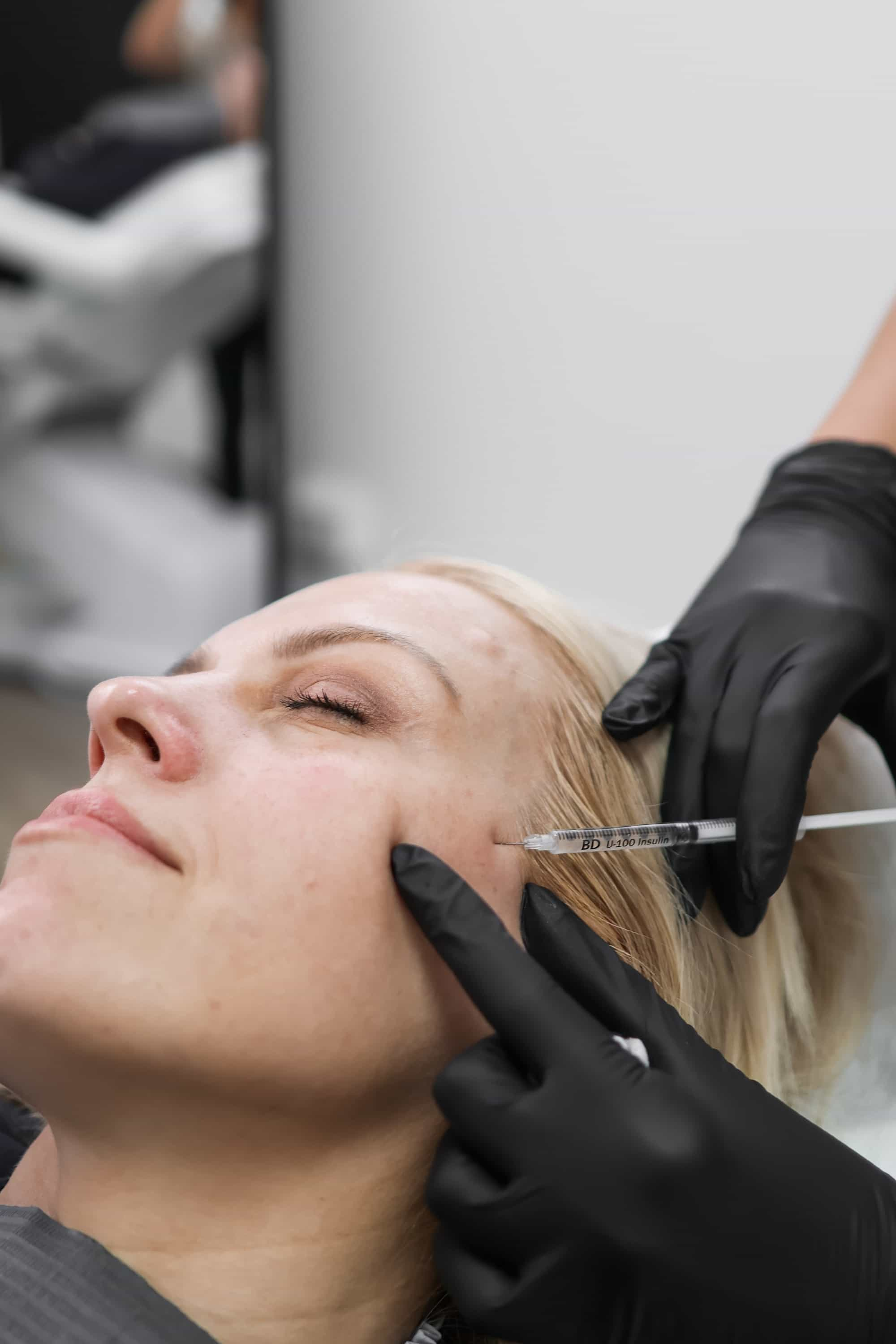Sculptra and Hydrated Skin
Sculptra and hydrated skin are often discussed together, but does the popular dermal filler actually improve hydration?
Mechanism of Action

Sculptra Aesthetic (poly-L-lactic acid) works by stimulating collagen production rather than directly hydrating the skin. When injected, Sculptra triggers a gradual immune response that leads to fibroblast activation. These fibroblasts then produce new collagen fibers, which provide structure and support to the skin. Increased collagen levels can result in improved skin firmness, volume, and a smoother appearance, indirectly contributing to better hydration by supporting the skin’s natural barrier function.
While Sculptra doesn’t directly add moisture to the skin like hyaluronic acid fillers, its long-lasting collagen-boosting effects can create an environment where skin appears plumper and more hydrated.
Clinical Studies
Clinical studies on Sculptra’s direct impact on skin hydration are limited. Most research focuses on its efficacy in addressing facial wrinkles, volume loss, and improving skin texture. Some studies suggest that the increased collagen production stimulated by Sculptra can indirectly enhance skin hydration by strengthening the skin’s barrier function and improving elasticity.

However, it is important to note that Sculptra does not provide the same immediate hydrating effect as hyaluronic acid fillers. While some patients may observe improved skin hydration as a secondary benefit of Sculptra treatment, it is not its primary mechanism of action.
Patient Testimonials in Surrey
Patients in Surrey seeking to improve their skin hydration often inquire about Sculptra Aesthetic. While Sculptra is renowned for its ability to stimulate collagen production and address facial wrinkles, volume loss, and skin texture concerns, its direct hydrating effects are less pronounced compared to hyaluronic acid fillers.
Many patients report experiencing a noticeable improvement in skin plumpness and a more hydrated appearance following Sculptra treatment. This can be attributed to the increased collagen production which strengthens the skin’s structure and barrier function.
However, it is crucial to understand that Sculptra does not directly add moisture to the skin like hyaluronic acid fillers do. Sculptra’s primary benefit lies in its long-lasting collagen stimulation, indirectly contributing to a more hydrated appearance over time.
Hydration vs. Volume Augmentation
The pursuit of healthy, radiant skin often leads individuals to explore various treatment options, and Sculptra has become increasingly popular in this quest. While Sculptra is widely known for its ability to address wrinkles and restore facial volume, the question of whether it directly improves hydration arises frequently. Understanding the distinction between hydration and volume augmentation is crucial when considering Sculptra as a solution.
Sculptra’s Primary Function
Sculptra Aesthetic (poly-L-lactic acid) is a dermal filler that works by stimulating collagen production rather than adding moisture to the skin like hyaluronic acid fillers.
Here’s how it differs from hydration-focused treatments:
- Hydration involves replenishing water content in the skin, often achieved through topical moisturizers or injectables like hyaluronic acid.
- Volume augmentation aims to restore lost facial volume and improve contours using fillers that add substance to the skin.
Sculptra’s primary function is volume augmentation. When injected, it triggers a gradual immune response that stimulates collagen production. Over time, this leads to increased collagen fibers, providing structure and support to the skin. This can result in improved firmness, smoother texture, and a more youthful appearance.
While Sculptra doesn’t directly hydrate the skin, its long-lasting collagen-boosting effects indirectly contribute to a plumper, more hydrated look by strengthening the skin’s barrier function and improving elasticity.
Indirect Hydration Effects
Sculptra and hydrated skin are often discussed together, but does the popular dermal filler actually improve hydration?
Sculptra Aesthetic (poly-L-lactic acid) works by stimulating collagen production rather than directly hydrating the skin. When injected, Sculptra triggers a gradual immune response that leads to fibroblast activation. These fibroblasts then produce new collagen fibers, which provide structure and support to the skin. Increased collagen levels can result in improved skin firmness, volume, and a smoother appearance, indirectly contributing to better hydration by supporting the skin’s natural barrier function.
While Sculptra doesn’t directly add moisture to the skin like hyaluronic acid fillers, its long-lasting collagen-boosting effects can create an environment where skin appears plumper and more hydrated.
Clinical studies on Sculptra’s direct impact on skin hydration are limited. Most research focuses on its efficacy in addressing facial wrinkles, volume loss, and improving skin texture. Some studies suggest that the increased collagen production stimulated by Sculptra can indirectly enhance skin hydration by strengthening the skin’s barrier function and improving elasticity.
However, it is important to note that Sculptra does not provide the same immediate hydrating effect as hyaluronic acid fillers. While some patients may observe improved skin hydration as a secondary benefit of Sculptra treatment, it is not its primary mechanism of action.
Patients in Surrey seeking to improve their skin hydration often inquire about Sculptra Aesthetic. While Sculptra is renowned for its ability to stimulate collagen production and address facial wrinkles, volume loss, and skin texture concerns, its direct hydrating effects are less pronounced compared to hyaluronic acid fillers.
Many patients report experiencing a noticeable improvement in skin plumpness and a more hydrated appearance following Sculptra treatment. This can be attributed to the increased collagen production which strengthens the skin’s structure and barrier function.
However, it is crucial to understand that Sculptra does not directly add moisture to the skin like hyaluronic acid fillers do. Sculptra’s primary benefit lies in its long-lasting collagen stimulation, indirectly contributing to a more hydrated appearance over time.
The pursuit of healthy, radiant skin often leads individuals to explore various treatment options, and Sculptra has become increasingly popular in this quest. While Sculptra is widely known for its ability to address wrinkles and restore facial volume, the question of whether it directly improves hydration arises frequently. Understanding the distinction between hydration and volume augmentation is crucial when considering Sculptra as a solution.
Sculptra Aesthetic (poly-L-lactic acid) is a dermal filler that works by stimulating collagen production rather than adding moisture to the skin like hyaluronic acid fillers.
Here’s how it differs from hydration-focused treatments:
- Hydration involves replenishing water content in the skin, often achieved through topical moisturizers or injectables like hyaluronic acid.
- Volume augmentation aims to restore lost facial volume and improve contours using fillers that add substance to the skin.
Sculptra’s primary function is volume augmentation. When injected, it triggers a gradual immune response that stimulates collagen production. Over time, this leads to increased collagen fibers, providing structure and support to the skin. This can result in improved firmness, smoother texture, and a more youthful appearance.
While Sculptra doesn’t directly hydrate the skin, its long-lasting collagen-boosting effects indirectly contribute to a plumper, more hydrated look by strengthening the skin’s barrier function and improving elasticity.
Other Factors Influencing Hydration
Numerous factors influence skin hydration beyond topical applications or dermal fillers. Environmental conditions such as humidity and temperature play a significant role, with dry climates tending to dehydrate skin. Lifestyle choices like diet, stress levels, and adequate sleep also impact skin health and moisture retention. Underlying medical conditions, certain medications, and even genetics can contribute to variations in skin hydration.
Lifestyle and Diet
Numerous factors influence skin hydration beyond topical applications or dermal fillers. Environmental conditions such as humidity and temperature play a significant role, with dry climates tending to dehydrate skin.
- Lifestyle choices like diet, stress levels, and adequate sleep also impact skin health and moisture retention.
- Underlying medical conditions, certain medications, and even genetics can contribute to variations in skin hydration.
Skincare Routine
Numerous factors influence skin hydration beyond topical applications or dermal fillers. Environmental conditions such as humidity and temperature play a significant role, with dry climates tending to dehydrate skin. Lifestyle choices like diet, stress levels, and adequate sleep also impact skin health and moisture retention. Underlying medical conditions, certain medications, and even genetics can contribute to variations in skin hydration.
Environmental Factors
Numerous factors influence skin hydration beyond topical applications or dermal fillers. Environmental conditions such as humidity and temperature play a significant role, with dry climates tending to dehydrate skin. Lifestyle choices like diet, stress levels, and adequate sleep also impact skin health and moisture retention.
Underlying medical conditions, certain medications, and even genetics can contribute to variations in skin hydration.
Schedule your Sculptra consultation with Dr. Laura Geige at It’s Me & You Clinic today.
- Skin Injectables Near Capel, Surrey - November 4, 2025
- Sculptra Surrey – Collagen Stimulation Therapy Near Shepperton, Surrey - November 3, 2025
- Sculptra Surrey – Collagen Stimulation Therapy Near Dunsfold, Surrey - November 1, 2025
